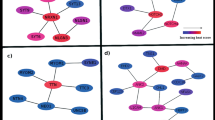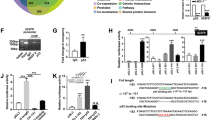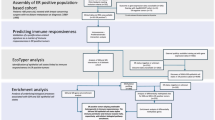Abstract
EBAG9 has been recently identified as an oestrogen responsive gene in MCF-7 human breast carcinoma cells. EBAG9 is identical to RCAS1, a cancer cell surface antigen possibly involved in immune escape. In this study, we examined the expression of EBAG9/RCAS1 in human breast carcinomas using immunohistochemistry and reverse transcription-polymerase chain reaction (RT-PCR). EBAG9 immunoreactivity was also associated with various clinicopathological parameters, including intratumoural infiltration of inflammatory cells, to examine the biological significance of EBAG9 in human breast carcinomas. EBAG9 immunoreactivity was detected in the entire surface and cytoplasm of carcinoma cells in 82 out of 91 invasive ductal carcinomas (90.1%). In non-neoplastic mammary glands, EBAG9 immunoreactivity was weakly present on the luminal surface of epithelial cells. Results from RT-PCR (n = 7) were consistent with those of immunohistochemistry. EBAG9 immunoreactivity was significantly associated with estrogen receptor (ER) α labelling index (P = 0.0081), and inversely associated with the degree of intratumoural infiltration of mononuclear cells (P = 0.0020), or CD3+ T lymphocytes (P = 0.0025). This study suggests that EBAG9 is produced via ER in carcinoma cells and inhibits the intratumoural infiltration of T lymphocytes in the context of a possible endocrine–immune interaction in human breast carcinomas. © 2001 Cancer Research Campaign http://www.bjcancer.com
Similar content being viewed by others
Article PDF
Change history
16 November 2011
This paper was modified 12 months after initial publication to switch to Creative Commons licence terms, as noted at publication
References
Alexieva-Figusch J, Van Putten WL, Blankenstein MA, Blonk-Van Der Wijst J and Klijn JG (1988) The prognostic value and relationships of patient characteristics, estrogen and progestin receptors, and site of relapse in primary breast cancer. Cancer 61: 758–768
An T, Sood U, Pietruk T, Cummings G, Hashimoto K and Crissman JD (1987) In situ quantitation of inflammatory mononuclear cells in ductal infiltrating breast carcinoma. Relation to prognostic parameters. Am J Pathol 128: 52–60
Balch CM, Riley LB, Bae YJ, Salmeron MA, Platsoucas CD, von Eschenbach A and Itoh K (1990) Patterns of human tumor-infiltrating lymphocytes in 120 human cancers. Arch Surg 125: 200–205
Black MM, Opler SR and Speer FD (1955) Survival in breast cancer cases in relation to the structure of the primary tumor and regional lymph nodes. Surg Gynecol Obstet 98: 543–551
Bloom HJG and Richardson WW (1957) Histological grading and prognosis in breast cancer. A study of 1409 cases of which 359 have been followed for 15 years. Br J Cancer 11: 359–377
Champion HR, Wallace IW and Prescott RJ (1972) Histology in breast cancer prognosis. Br J Cancer 26: 129–138
DiPaola M, Bertolotti A, Colizza S and Coli M (1977) Histology of bronchial carcinoma and regional lymph nodes as putative immune response of the host to the tumor. J Thorac Cardiovasc Surg 73: 531–537
Dotzlaw H, Leygue E, Watson PH and Murphy LC (1999) Estrogen receptor-beta messenger RNA expression in human breast tumor biopsies: relationship to steroid receptor status and regulation by progestins. Cancer Res 59: 529–532
Elston CW and Ellis IO (1991) Pathological prognostic factors in breast cancer. I. The value of histological grade in breast cancer. Experience from a large study with long-term follow-up. Histopathology 19: 403–410
Enmark E, Pelto-Huikko M, Grandien K, Lagercrantz S, Lagercrantz J, Fried G, Nordenskjold M and Gustafsson JA (1997) Human estrogen receptor beta-gene structure, chromosomal localization, and expression pattern. J Clin Endocrinol Metab 82: 4258–4265
Hamada Y, Yamamura M, Hioki K, Yamamoto M, Nagura H and Watanabe K (1985) Immunohistochemical study of carcinoembryonic antigen in patients with colorectal cancer. Correlation with plasma carcinoembryonic antigen levels. Cancer 55: 136–141
Hamlin IM (1968) Possible host resistance in carcinoma of the breast: a histological study. Br J Cancer 22: 383–401
Horwitz KB and McGuire WL (1978) Estrogen control of progesterone receptor in human breast cancer. Correlation with nuclear processing of estrogen receptor. J Biol Chem 253: 2223–2228
Ichihara T, Nagura H, Nakao A, Sakamoto J, Watanabe T and Takagi H (1988) Immunohistochemical localization of CA 19–9 and CEA in pancreatic carcinoma and associated diseases. Cancer 61: 324–333
Ikeda K, Sato M, Tsutsumi O, Tsuchiya F, Tsuneizumi M, Emi M, Imoto I, Inazawa J, Muramatsu M and Inoue S (2000) Promoter analysis and chromosomal mapping of human EBAG9 gene. Biochem Biophys Res Commun 273: 654–660
Iwasaki T, Nakashima M, Watanabe T, Yamamoto S, Inoue Y, Yamanaka H, Matsumura A, Iuchi K, Mori T and Okada M (2000) Expression and prognostic significance in lung cancer of human tumor-associated antigen RCAS1. Int J Cancer 89: 488–493
Jarvinen TA, Pelto-Huikko M, Holli K and Isola J (2000) Estrogen receptor beta is coexpressed with ERalpha and PR and associated with nodal status, grade, and proliferation rate in breast cancer. A J Pathol 156: 29–35
Kaku T, Sonoda K, Kamura T, Hirakawa T, Sakai K, Amada S, Ogawa S, Kobayashi H, Nakashima M, Watanabe T and Nakano H (1999) The prognostic significance of tumor-associated antigen 22–1–1 expression in adenocarcinoma of the uterine cervix. Clin Cancer Res 5: 1449–1453
Kuiper GG, Enmark E, Pelto-Huikko M, Nilsson S and Gustafsson JA (1996) Cloning of a novel receptor expressed in rat prostate and ovary. Proc Nat Acad Sci USA 93: 5925–5930
Moore OS Jr. and Foote FW Jr. (1949) The relatively favorable prognosis of medullary carcinoma of the breast. Cancer 2: 635–642
Mosselman S, Polman J and Dijkema R (1996) ER beta: identification and characterization of a novel human estrogen receptor. FEBS Letters 392: 49–53
Naito Y, Saito K, Shiiba K, Ohuchi A, Saigenji K, Nagura H and Ohtani H (1998) CD8+ T cells infiltrated within cancer cell nests as a prognostic factor in human colorectal cancer. Cancer Res 58: 3491–3494
Nakashima M, Sonoda K and Watanabe T (1999) Inhibition of cell growth and induction of apoptotic cell death by the human tumor-associated antigen RCAS1. Nature Med 5: 938–942
Ogawa S, Inoue S, Watanabe T, Hiroi H, Orimo A, Hosoi T, Ouchi Y and Muramatsu M (1998a) The complete primary structure of human estrogen receptor beta (hER beta) and its heterodimerization with ER alpha in vivo and in vitro. Biochem Biophys Res Commun 243: 122–126
Ogawa S, Inoue S, Watanabe T, Orimo A, Hosoi T, Ouchi Y and Muramatsu M (1998b) Molecular cloning and characterization of human estrogen receptor betacx: a potential inhibitor of estrogen action in human. Nucl Acid Res 26: 3505–3512
Paige LA, Christensen DJ, Gron H, Norris JD, Gottlin EB, Padilla KM, Chang CY, Ballas LM, Hamilton PT, McDonnell DP and Fowlkes DM (1999) Estrogen receptor (ER) modulators each induce distinct conformational changes in ER alpha and ER beta. Proc Natl Acad Sci USA 96: 3999–4004
Ponte P, Ng SY, Engel J, Gunning P and Kedes L (1984) Evolutionary conservation in the untranslated regions of actin. Nucleic Acids Res 12: 1687–1696
Pujol P, Rey JM, Nirde P, Roger P, Gastaldi M, Laffargue F, Rochefort H and Maudelonde T (1998) Differential expression of estrogen receptor-alpha and -beta messenger RNAs as a potential marker of ovarian carcinogenesis. Cancer Research 58: 5367–5373
Rosenberg SA (1996) The immunotherapy of solid cancers based on cloning the genes encoding tumor-rejection antigens. Ann Rev Med 47: 481–491
Sasano H, Suzuki T, Matsuzaki Y, Fukaya T, Endoh M, Nagura H and Kimura M (1999) Messenger ribonucleic acid in situ hybridization analysis of estrogen receptors alpha and beta in human breast carcinoma. J Clin Endocrinol Metab 84: 781–785
Skliris GP, Carder PJ, Lansdown MR and Speirs V (2001) Immunohistochemical detection of ERbeta in breast cancer: towards more detailed receptor profiling?. Br J Cancer 84: 1095–1098
Sonoda K, Nakashima M, Kaku T, Kamura T, Nakano H and Watanabe T (1996) A novel tumor-associated antigen expressed in human uterine and ovarian carcinomas. Cancer 77: 1501–1509
Speirs V, Parkes AT, Kerin MJ, Walton DS, Carleton PJ, Fox JN and Atkin SL (1999) Coexpression of estrogen receptor alpha and beta: poor prognostic factors in human breast cancer?. Cancer Res 59: 525–528
Takeyama J, Suzuki T, Inoue S, Kaneko C, Nagura H, Harada N and Sasano H (2001) Expression and cellular localization of estrogen receptors alpha and beta in human fetus. J Clin Endocrinol Metab 86: 2258–2262
Thomas DB (1984) Do hormones cause cancer?. Cancer 53: 595–604
Tsai MJ and O’Malley BW (1994) Molecular mechanisms of action of steroid/thyroid receptor superfamily members. Ann Rev Biochem 63: 451–486
Tsuchiya F, Ikeda K, Tsutsumi O, Hiroi H, Momoeda M, Taketani Y, Muramatsu M and Inoue S (2001) Molecular cloning and characterization of mouse EBAG9, homolog of a human cancer associated surface antigen: expression and regulation by estrogen. Biochem Biophys Res Commun, in press
Vihko R and Apter D (1989) Endogenous steroids in the pathophysiology of breast cancer. CRC Crit Rev Oncol/Hematol 9: 1–16
Vladusic EA, Hornby AE, Guerra-Vladusic FK, Lakins J and Lupu R (2000) Expression and regulation of estrogen receptor beta in human breast tumors and cell lines. Oncol Rep 7: 157–167
Vose BM and Moore M (1979) Suppressor cell activity of lymphocytes infiltrating human lung and breast tumours. Int J Cancer 24: 579–585
Vose BM, Vanky F and Klein E (1977) Human tumour—lymphocyte interaction in vitro. V. Comparison of the reactivity of tumour-infiltrating, blood and lymph-node lymphocytes with autologous tumour cells. Int J Cancer 20: 895–902
Watanabe T, Inoue S, Hiroi H, Orimo A, Kawashima H and Muramatsu M (1998) Isolation of estrogen-responsive genes with a CpG island library. Mol Cell Biol 18: 442–449
Whitford P, Mallon EA, George WD and Campbell AM (1990) Flow cytometric analysis of tumour infiltrating lymphocytes in breast cancer. Br J Cancer 62: 971–975
Author information
Authors and Affiliations
Rights and permissions
From twelve months after its original publication, this work is licensed under the Creative Commons Attribution-NonCommercial-Share Alike 3.0 Unported License. To view a copy of this license, visit http://creativecommons.org/licenses/by-nc-sa/3.0/
About this article
Cite this article
Suzuki, T., Inoue, S., Kawabata, W. et al. EBAG9/RCAS1 in human breast carcinoma: a possible factor in endocrine–immune interactions. Br J Cancer 85, 1731–1737 (2001). https://doi.org/10.1054/bjoc.2001.2176
Received:
Revised:
Accepted:
Published:
Issue date:
DOI: https://doi.org/10.1054/bjoc.2001.2176
Keywords
This article is cited by
-
Extracellular vesicle-mediated EBAG9 transfer from cancer cells to tumor microenvironment promotes immune escape and tumor progression
Oncogenesis (2018)
-
EBAG9 modulates host immune defense against tumor formation and metastasis by regulating cytotoxic activity of T lymphocytes
Oncogenesis (2014)
-
Toxicogenomic and signaling pathway analysis of low-dose exposure to cadmium chloride in rat liver
Molecular & Cellular Toxicology (2013)
-
Accuracy of differential diagnosis for pancreatic cancer is improved in the combination of RCAS1 and CEA measurements and cytology in pancreatic juice
Medical Molecular Morphology (2011)
-
The association between RCAS1 expression in laryngeal and pharyngeal cancer and its healthy stroma with cancer relapse
BMC Cancer (2009)



